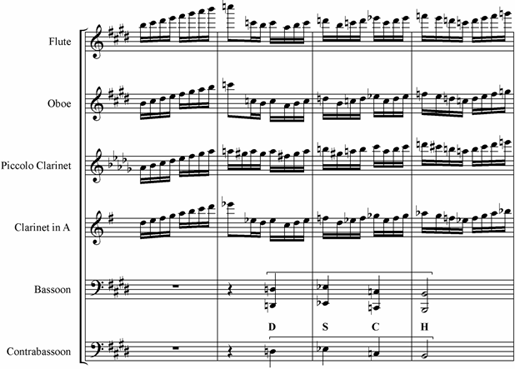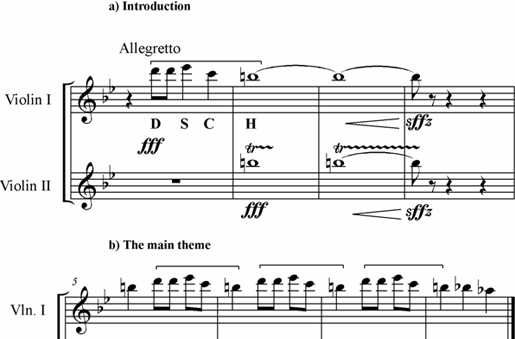Shostakovich's Piano Sonata No. 2 (cont'd)
Epilogue
Evolution and Transformation of the 'Diminished Tetrachords' in the Later Works of Shostakovich
The middle period was the time for an extensive formulation of the composer’s major principles of composition and of his development of musical material. The Sonata appears to be the one of the most important works where these principles are extensively used. It is important, however, to trace the evolution of these principles in other works of a later period. This should allow for a better understanding of the place of the Sonata in the evolutionary process of Shostakovich’s unique individual style.
As was previously described, the diminished tetrachord (e.g., the four-note stepwise structure within a diminished fourth) is one of the most distinctive elements of Shostakovich’s works of the period. During the middle period of his life, the diminished tetrachords became Shostakovich’s ‘identification’ motives and were frequently used to express the composer’s ‘self’ throughout his works. Shostakovich, probably more than anyone else among his contemporaries, needed to preserve his genuine ‘self” in his music, since the political situation in the country made his very existence extremely ambiguous.
As was also noted in the introduction, after being denounced for the composition of the opera Lady Macbeth (1936), Shostakovich in the middle period of his life turned to more intimate musical genres, specifically to string quartets. The First Quartet was written in 1938 (before the Sonata), the others – in later periods of his life. Among the most dramatic and expressive quartets are the Fifth Quartet (1952) and the Eighth Quartet (1960) – two works that allow us to trace Shostakovich’s ‘identification’ motives through their evolution.
The Fifth Quartet in Bb Major is a three-movement cycle. The first movement is a scene of dramatic collisions. The first bars of the first theme expose the conflict between the composer’s ‘self’ and the surrounding world. The composer clearly identifies himself with the diminished tetrachord motive – [C – D – Eb – B] – C# – which is rhythmically and texturally separated (in the viola part) from other thematic elements (cello and violins). The inclusion of C# at the end of this motive makes it sound harsh and wailing (collision of C and C# within the same short motive). In addition, Shostakovich places this motive (which belongs rather to B minor as in the Sonata) in a B flat Major atmosphere (the composer, as usual, briefly identifies the tonic at the very beginning of the piece) where it sounds like a complete stranger. (In my own interpretation, a stranger here finds himself in the wrong place and in the wrong crowd and tries to figure out how to deal with it.) See Example 34.
One of the most distinguished features of the Fifth Quartet is the continuity of the entire three-movement cycle. In my view, the most important element that keeps all these parts together is the ‘self’ motive, which reappears in the third movement, in the second violin part, but is transformed into the three-note motive, with the C missing, clearly within the ‘LDT’ (B natural – D - Eb). See Example 35. In the very climax of the development (Example 36), the ‘UDT’ is used (in the first violin part – Fb – Eb – Db – C, in the second violin part – Db – C – Bb - A).
Example 34. The Fifth String Quartet, beginning of the First Movement.
Bracketed is the UDT in the Viola part.

Example 35. The Fifth String Quartet, Third Movement.
Bracketed is the 'incomplete', three-note 'monogram' motive in the Violin II part.

Example 36. The Fifth String Quartet. Development—Climax of the Third Movement.
Bracketed is the 'UDT' in thirds, in two violins' parts.

The three-note version of the ‘self’ motive used in the finale of the Fifth Quartet is a mid-step to the composer’s full four-note monogram: D – Eb – C – B. (The Latin version is D – S – C – H, which stands for D. Sch-ostakovich.) It will then appear in his Tenth Symphony (written one year later – in 1953) as a transformation of the main motive of the Scherzo (the third movement). See Example 37. It then appears again (mighty fortissimo in low winds and strings) in the coda of the finale. See Example 38.
Finally, the ‘matured’ monogram appears in one of Shostakovich’s most ingenious works - the Eighth Quartet (1960) dedicated “To the memory of the victims of war and fascism”.31 It is a tragic, mournful fugato theme from which the first movement of the quartet emerges. See Example 39. The ‘monogram’ motive is then transformed into the main theme of the third movement (scherzo). See Examples 40 a) and b).
Example 37. The Tenth Symphony, Third Movement ('Scherzo').
Bracketed is the 'monogram' motive.

Example 38. The Tenth Symphony, Finale, Coda.
Bracketed is the 'monogram' motive in the Bassoon and Contrabassoon parts.

Example 39. The Eighth String Quartet, First Movement (the Fugue).
The 'monogram' motive is a fugue subject.

Example 40. The Eighth String Quartet, Third Movement (Scherzo).
Bracketed is the 'monogram' motive.

In this five-movement quartet, Shostakovich creates a perfect symmetrical structure. The final movement is actually a modified restatement of the first: another largo in the form of a fugue on the ‘monogram’ theme returns in the cello part. See Example 41. It perfectly frames the entire cycle.
Example 41, The Eighth String Quartet, beginning of the Finale (the fugue).
Bracketed is the 'monogram' motive in the Violoncello part.

Thus, the Eighth Quartet is the climactic point in the development of the ‘self’ motives in Shostakovich’s works. This work was the composer’s immediate response to the coercive actions of the Soviet government, which forced him to join the Communist Party (the two events – becoming a Party member and composing the quartet - happened one after another in June and July of 1960 - see Preface). In a letter written soon after the quartet’s completion, Shostakovich mentioned that he had written an ‘ideologically deficient quartet’, which is indeed a work dedicated to his memory.”32 In the Eighth Quartet, Shostakovich makes the ‘monogram’ (‘self’) theme a leitmotive of the entire piece, identifying himself with the victims of war and fascism, since he was in reality a victim of Stalinism and the Communist regime.
« Previous: Summary
Footnotes
31 This dedication was a result of coercion from the Soviet government officials. Initially, Shostakovich wanted to dedicate the Eighth Quartet to his own memory. As Maxim Shostakovich noticed, ‘the word “fascism” should be interpreted as a synonym to “totalitarianism”, of which the composer was a victim’.
32 L. Fay, 217.

Comments
October 17th, 2010
Philip Czaplowski:
Hello Sophia, I just wanted to say how interesting and informative I found your material about the Shostakovich 2nd Piano Sonata. I was listening to a recording of Emil Gilels performing it, and was looking for some background information on the work. Thanks again! I am a composer, and one of my major influences is Shostakovich. If you are interested, my website has recordings at www.czaplowski.com. Thanks again. Best wishes from Australia!
September 9th, 2017
Sam Rontos:
Dear Sophia, I have just read your comprehensive notes on Shostakovich\'s Piano Sonata No.2. Like your previous reader, I have just listened to a performance of the sonata by Emil Gilels which I really enjoyed. I am slowly learning more and more about the theoretical aspects of music composition so I found your comments extremely helpful. Thank you for your wonderful insight into this wonderful work.
Leave a comment